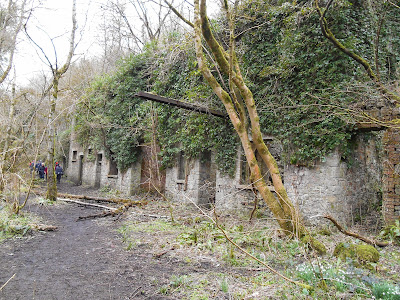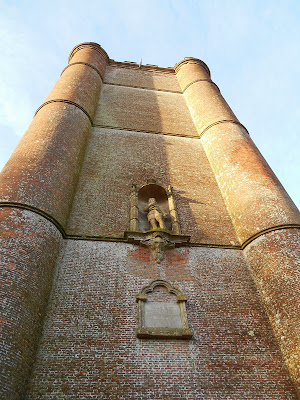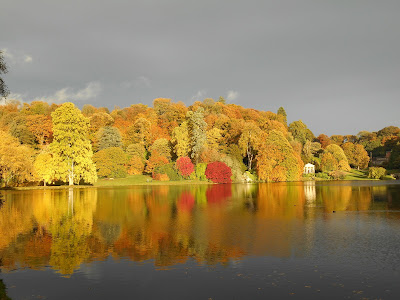There are only 13 aqueducts listed on the Somerset Historic Environment Record:
- 5 on the Chard Canal: 3 in Creech St Michael and 2 at Wrantage.
- 5 on the Grand Western Canal: 2 at Nynehead, 1 at Bishops Hull, 1 at Station Road, Taunton and 1 which carried a stream over the canal at Greenham.
- 2 on the Dorset and Somerset Canal: the Murtry Aqueduct at Hapsford and the wonderfully named Hucky Duck at Coleford.
- 1 on the Glastonbury Canal at Sharpham. This carried the Glastonbury Canal over Hulk Moor Drove
None of them are in use today, as all the canals they were on are disused or were never completed.
The Hucky Duck at Coleford
The Dorset and Somerset Canal was planned in the 1790s to run from the Kennet and Avon Canal near Bath to Poole in Dorset with a branch from Frome to the Somerset Coalfield at Nettlebridge. Coleford Aqueduct, which is known locally as the Hucky Duck, was on the branch. However the canal was never completed due to lack of funds and the project was abandoned in 1803. A public footpath passes under the aqueduct, which is located 100 metres to the north of the Coleford to Holcombe road at the southern end of the village of Coleford (grid reference ST 685 488). There is no sign to it but it can be seen from the public road. Parking is difficult nearby, as the road is narrow and most of the nearby houses do not have off road parking.

Murtry Aqueduct
This is all I could see of the Murtry Aqueduct, as the site was very overgrown when I visited in August 2016. I believe this is the west access tunnel. I would have investigated further but there was a tent pitched on the north side of the aqueduct and I didn't want to disturb anyone who might have been in it, so I took this photo and left.
The Murtry Aqueduct was built between 1796 and 1803 to carry the (never completed) Frome branch of the Dorset and Somerset Canal over the River Mells at Murtry Bottom between Frome and Buckland Dinham (grid reference ST 762 497). The aqueduct has 3 arches.
Iron trough of the aqueduct over the River Tone on the former Grand Western Canal at Nynehead
(Grid reference ST 146 223)
This aqueduct can be seen from a public footpath.
Aqueduct that carried the Grand Western Canal over the driveway to Nynehead Court.
This aqueduct (grid reference ST 144 218) can be viewed from a public footpath. It is located immediately to the west of the remains of the Nynehead Boat Lift. The Grand Western Canal was part of a scheme to link the Bristol Channel with the English Channel, so that shipping could avoid having to travel around the coast of Cornwall. It was also built to transport goods, including coal, into the middle of Somerset and Devon. It was completed from Tiverton to Westleigh in 1814 but the section to Taunton wasn't completed until 1838. It was used mainly to transport coal and limestone. When nearby railways were built, it lost most of its trade. The section from Taunton to Loudwells was bought by the railway company and abandoned in 1865. The Devon section continued to be used until 1925.
North side of the aqueduct on the Chard Canal south of Creech St Michael
This aqueduct carried the canal over the road that runs between Henlade/Ruishton and Creech St Michael. The Chard Canal was a 13 mile long tug boat canal. It branched off the Bridgwater and Taunton Canal at Creech St Michael. It was completed in 1842 but never made a profit and by 1853 it had gone into receivership. It closed in 1866.
Southern side of the aqueduct on the Chard Canal south of Creech St Michael
The remains of this aqueduct (grid reference ST 271 250) can be viewed from the public road, which runs between Ruishton/Henlade and Creech St Michael.
Chard Canal Aqueduct over the River Tone at Creech St Michael
This aqueduct (grid reference ST 271 254) can be viewed from a public footpath.
Nothing now remains of another aqueduct, which Brunel built nearby to carry the Chard Canal over the railway line.
Pillar of the Chard Canal Aqueduct at Wrantage
Remains of the aqueduct, which once carried the Chard Canal over the A378 at Wrantage and southwards towards the Crimson Hill Tunnel (grid reference ST 308 225)
Remains of Chard Canal Aqueduct at Wrantage
Grid Reference: ST 305 228
Chard Canal Aqueduct at Wrantage
This once carried the canal over a small stream
Railway bridge at Station Road, Taunton
It replaced an aqueduct, which carried the Grand Western Canal. The railway bridge was formerly used by a loop line round the nearby station but is due to be replaced by a road bridge in summer 2015. Update Summer 2016: the bridge has been removed but the new bridge has yet to be installed.
Aqueduct, which carried a stream over the Grand Western Canal at Greenham
There is still some water in the canal at this point but no sign of the stream the aqueduct was built to carry. Grid reference ST 078 198
There are also several notable aqueducts in the Bath & North East Somerset Council area, including the Midford Aqueduct on the Somerset Coal Canal and the Dundas and Avoncliff Aqueducts on the Kennet & Avon Canal. The latter two aqueducts are still in use.
Midford Aqueduct
Midford Aqueduct
The Midford Aqueduct on the Radstock branch of the Somerset Coal Canal was completed in 1803. The Somerset Coal Canal was built to transport coal from the mines in the Radstock and Timsbury/Paulton areas to the Kennet and Avon Canal, which it joined near the Dundas Aqueduct at Limpley Stoke. The Radstock branch of the canal was never completed and a tramway was used to transport coal from the Radstock pits to a point close to the Midford Aqueduct. The aqueduct, which is Palladian in style and has 3 arches, was built to carry the canal over the Cam Brook. It has a rubble core faced with Bath stone ashlar . In 1871 the Radstock branch was sold to the Somerset & Dorset Joint Railway. They built a railway along the route of the tramway. The remainder of the Somerset Coal Canal closed in 1898. By the 1990s the aqueduct was in danger of collapsing. It was restored 2000-2001 by the Avon Industrial Buildings Trust and the Midford Environmental Group.
Dundas Aqueduct
Dundas Aqueduct was built by John Rennie and completed in 1805. It carries the Kennet & Avon Canal over the River Avon to the north of the village of Limpley Stoke. It was named after Charles Dundas, who was the first Chairman of the Kennet & Avon Canal Company. It has a large hemispherical central arch and elliptical side arches, with sloping revetments acting as buttresses on each side. A Doric frieze runs the length of the aqueduct.
Narrowboat crossing the Dundas Aqueduct
Avoncliff Aqueduct
The Avoncliff Aqueduct was also built by John Rennie between 1797 and 1801. It carries the Kennet & Avon Canal over the River Avon at Avoncliff. It has 3 arches and is 100 metres long. The central arch has a slight sag in it and has done since it was first built.
Avoncliff Aqueduct
Avoncliff Aqueduct
Further Reading:
The Dorset and Somerset Canal: An Illustrated History by Kenneth R. Clew. Published by David and Charles in 1971.
The Chard Canal by Chard Local History Group. Pamphlet published in 1967 and 2nd edition in 1972.
The Grand Western Canal by Helen Harris. Published by David and Charles in 1973.
Glastonbury Canal by Geoffrey Body. Published by Fiducia Press in 2001

















































